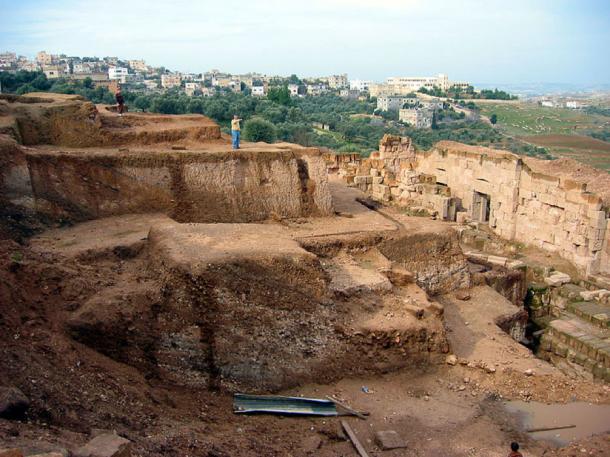
Bizarre Comical Frescoes Complete with Speech in a Lost Hybrid Language Found in Jordan Tomb
Archaeologists digging in Jordan have unearthed a Roman tomb decorated with colorful frescoes including ancient “comic writing bubbles” scribed in Aramaic using Greek letters.
The remarkable collection of over 260 detailed drawings illustrate the diverse and rich cultural environments of Hellenistic border towns while under the rule of the Roman empire, according to a report in Haaretz. Having been buried for over 2,000 years, late in 2016 road workers digging “in front of a school in the Jordanian village of Beit Ras, just north of Irbid” (80km/50 miles north of Amman) discovered what is now believed to be “part of a necropolis in the ancient Greco-Roman settlement of Capitolias," reports the CNRS, France’s National Center for Scientific Research.

The tomb was found in Beit Ras, on the outskirts of Irdid, Jordan. Here Capitolias theater at the archaeological dig site outside the town, with Beit Ras in the background. (CC BY-SA 4.0)
A team of international researchers has since studied “the 52-square-meter tomb which is divided into two burial chambers and contains a large basalt sarcophagus, all in very good condition considering that there are indications the tomb has been looted in the past,” says archaeologist and epigraphist Julian Aliquot who led the research project. The excavation and restoration project is being supported by a consortium of French, Italian and U.S. institutions, as well as the Jordanian Department of Antiquities. The department’s general director, Monther Jamhawi, told the Jordan Times “that authorities are also working to make the unique burial accessible to tourists.”
The Building of Capitolias
The city was founded in the late 1st century AD, and the tomb’s walls were found to be covered with paintings depicting “scenes of pagan iconography and images of daily life.” And this is why the discovery is so valuable, rather than depicting gods and mythological beings this tomb offers an insight into “real life” in ancient times. Humans are illustrated bringing foods to gods, who are shown eating happily, while peasants tend to the surrounding fields and vineyards, as construction workers build a city rampart.
Interpreted as a whole, the paintings depict the different phases involved in the founding an ancient Roman city, which Aliquot told reporters included scenes of people:
“consulting the gods on the appropriate site, clearing the plot, raising the walls, and finally, offering a sacrifice of thanks to the patron deity – in this case Jupiter Capitolinus, who gave the name to the city of Capitolias and was also the protector of Rome itself.”

Fresco from the walls of Beit Bas Roman tomb. (YouTube Screenshot)
Whose tomb is this?
Attempting to answer ‘who might have been buried in such a tomb?’ Pierre-Louis Gatier, a historian with the History and Sources of the Ancient World lab in Lyon, France told reporters at Inquisitr:
"According to our interpretation, there is a very good chance that the figure buried in the tomb is the person who had himself represented while officiating in the sacrifice scene from the central painting, and who consequently was the founder of the city.”
- Garshu, Gerasa, Jerash: the Everchanging City of the Ancient World
- Set of 70 Metal Tablets May Have the Earliest Written Account and Depiction of Jesus
- Some Giant Geoglyphs in Jordan are Older than the World Famous Nazca Lines

Comic like speech ‘bubbles’ were found on Roman tomb in Jordan. (Image: CNRS)
While researchers celebrated the painting there was a specific discovery that crowned the entire study. Approximately 60 inscriptions written in Greek accompanying the images identify the ruling deities, but the researchers found other texts written using Greek letters but in Aramaic, which was spoken by the Semitic peoples of the Near East. These “comic speech bubbles” describe what people are doing, for example, one figure says “I am cutting” while obviously slicing a stone. And a second example depicts someone declaring “Alas for me! I am dead” which experts interpret as coming from someone who had been the victim of an accident on the building site.
While today, we associate the word comic with humor, this is wrong. Although these paintings can be called detailed, culturally priceless and remarkable, they are certainly not funny. But in its truest definition, comics, are “any medium used to express ideas by still images, often combined with text or other visual information.” These are the oldest Greco-Aramaic “comics” ever discovered and the site archaeologists told reporters that the mixing of the “two main languages” is a “very rare phenomenon.” They also said that the mixing, “produces bizarre grammatical effects, such as the fact that the Aramaic words transcribed in Greek letters include vowels. Aramaic is written without vowels, as is its close linguistic relative, Hebrew.”
Top image: The frescos narrate everyday scenes of life in the town. Source: CNRS
By Ashley Cowie















